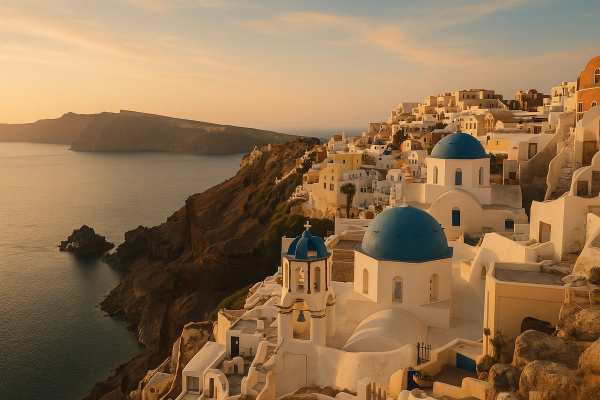
The Call of the Open Road & Our Planet's Plea: Reducing Your Carbon Footprint While Traveling#
Ah, the sheer thrill of travel! That electric buzz when you step off a plane into somewhere utterly new, the taste of an unfamiliar spice, the panorama from a mountain peak, the rhythm of a foreign city... it’s intoxicating, isn't it? For many of us, exploring the world isn't just a hobby; it's woven into the fabric of who we are. But as we chase horizons, there's a growing, undeniable whisper (sometimes a roar) reminding us of our impact. The very journeys that enrich our lives leave a mark on the planet we love to explore. The good news? We don't have to choose between our passion for adventure and our responsibility to the Earth. This guide is packed with practical reduce travel carbon footprint tips, exploring how we can embrace Sustainable Travel and Responsible Travel without sacrificing the magic.¶
It’s not about guilt-trips or giving up exploration altogether. It’s about becoming more conscious adventurers, making smarter choices, and finding ways to tread a little lighter. I’ve spent years navigating bustling souks, trekking remote trails, and crisscrossing continents, and along the way, I've learned (often through trial and error!) numerous ways to minimize my environmental impact. Let's dive into some practical strategies for reducing your carbon footprint while traveling.¶
Understanding Our Travel Footprint: Why Does it Matter?#
First up, what exactly is a travel carbon footprint? Simply put, it’s the total amount of greenhouse gases (primarily carbon dioxide) generated by our travel activities. This includes everything from the big-ticket items like flights and ground transport to seemingly smaller things like the energy used by our hotel, the food we eat, and the souvenirs we buy. Every choice contributes.¶
Why should we care? Because these emissions contribute directly to climate change, threatening the beautiful ecosystems, unique cultures, and stunning landscapes we travel so far to see. Melting glaciers, rising sea levels impacting coastal communities, extreme weather events – these aren't abstract concepts; they're actively changing the world we explore. Reducing our footprint is about preserving these precious places for future generations of travellers and, more importantly, for the people who call them home. It’s about ensuring the magic endures.¶
Did you know? Aviation alone accounts for roughly 2.5% of global CO2 emissions, and its impact is amplified at high altitudes. While that number might seem small, the emissions per passenger, especially on long-haul flights, can be substantial.
Before You Go: Planning for a Lighter Footprint#
Thoughtful planning is your secret weapon for more sustainable travel. Long before you zip up your suitcase, you can make choices that significantly lessen your impact.¶
Choosing Your Destination Wisely#
Sometimes, the most sustainable trip is the one closer to home. Consider exploring the wonders in your own backyard or region, accessible by train or carpooling. If venturing further afield, think about 'slow travel' – spending longer in one place rather than frantic country-hopping. This not only cuts down on transport emissions but allows for a deeper, more meaningful connection with the destination.¶
- Go Slow: Opt for immersive, longer stays in a single region or country over whirlwind multi-destination tours requiring frequent flights.
- Consider Overtourism: Research destinations struggling with visitor numbers and perhaps choose less-crowded, equally beautiful alternatives. This spreads tourism benefits and reduces strain on popular spots.
- Seek Sustainable Pledges: Look for destinations actively promoting eco-tourism, investing in green infrastructure, or protecting natural areas. Websites like the Global Sustainable Tourism Council (GSTC) can offer insights.
The Big One: Rethinking Your Flight Choices#
Let's be honest: flights are often the elephant in the room when discussing travel carbon footprints. For many long-distance journeys, they're unavoidable. However, how you fly makes a difference. Making informed flight choices is key.¶
- Fly Direct: Takeoffs and landings are the most fuel-intensive parts of a flight. Non-stop routes significantly reduce emissions compared to connecting flights.
- Choose Greener Airlines: Some airlines invest more heavily in newer, fuel-efficient aircraft (like the A320neo or Boeing 787 Dreamliner). Resources like the Atmosfair Airline Index or Google Flights' carbon estimates (though not perfect) can offer comparative data.
- Fly Economy: Business and first-class seats take up significantly more space, meaning your share of the flight's emissions is higher. Flying economy is the most carbon-efficient way to travel by air.
- Explore Alternatives: Is flying the only option? For journeys within Europe, extensive high-speed rail networks (like the Eurostar, TGV, or Deutsche Bahn) offer fantastic, lower-carbon alternatives. Similarly, India boasts a vast and culturally rich train system. Overnight buses or ferries can also be viable, often more scenic, options for certain routes.
My first overnight train journey across India wasn't just about reducing my footprint; watching the landscape unfold, sipping chai at station stops, and chatting with fellow passengers became an unforgettable part of the adventure itself. Don't underestimate the joy of the journey!
Packing Light: Less Weight, Less Carbon (and Happier Shoulders!)#
Every kilogram counts! Heavier planes burn more fuel, and heavier bags mean more effort (and potentially fuel) for ground transport too. Packing light isn't just eco-friendly; it makes navigating airports, train stations, and cobblestone streets so much easier. Trust me on this one.¶
- Invest Wisely: Choose durable, lightweight luggage. A slightly more expensive lightweight bag pays dividends in the long run.
- Curate Your Wardrobe: Pack versatile items that can be mixed and matched. Think layers. Plan outfits beforehand to avoid bringing items 'just in case'.
- Go Solid: Swap liquid toiletries for solid bars (shampoo, conditioner, soap, even sunscreen). They last longer, reduce plastic waste, and aren't subject to liquid restrictions.
- Share the Load: Traveling with others? Coordinate shared items like chargers, hair dryers, or guidebooks.
- The Golden Question: Before packing anything, ask yourself honestly: "Will I definitely use this more than once?" If the answer is hesitant, leave it behind.
On the Ground: Greener Choices During Your Trip#
Your sustainable efforts don't stop once you arrive. Daily choices about ground transport, accommodation, and consumption patterns significantly shape your overall footprint.¶
Mastering Low-Carbon Ground Transport#
Once at your destination, resist the urge to immediately hail a cab or rent a car for solo travel. Exploring on foot or by bicycle is the ultimate zero-carbon option and often the best way to discover hidden gems. Embrace local public transport – it’s usually efficient, affordable, and offers a glimpse into local life.¶
| Mode | Carbon Impact (Approx.) | Cost (General) | Experience |
|---|---|---|---|
| Walking / Cycling | Zero / Very Low | Free | Immersive, healthy, best for discovery |
| Public Transport (Bus/Tram/Metro) | Low | $ | Efficient in cities, local feel, good coverage (e.g., London Tube, Delhi Metro) |
| Intercity Trains / Buses | Low-Medium | $$-$$$ | Scenic, efficient for longer distances, comfortable (e.g., Amtrak in USA, National Express in UK) |
| Ride-Sharing (Pooled) | Medium | $$ | Convenient, better than solo taxi if pooled |
| Taxis / Private Hire Car | High | $$-$$$$ | Direct, convenient but high individual footprint |
| Rental Car (Petrol/Diesel) | High | $$$ - $$$$ | Flexible for remote areas, but significant emissions, especially for larger vehicles |
| Rental Car (Electric - EV) | Low (depends on grid) | $$$ - $$$$ | Lower emissions if charged with renewables, check charging infrastructure |
Using public transport in a new place can feel intimidating, but apps like Google Maps, Citymapper, or local transit apps make navigation much easier. Don't be afraid to ask locals for help – it often leads to friendly interactions! If renting a car is necessary for exploring remote areas, consider the smallest, most fuel-efficient model possible, or look into EV options if charging stations are readily available.¶
Accommodation: Sleeping Sustainably#
Where you lay your head also has an environmental impact. Hotels consume significant amounts of energy and water and generate waste. Making conscious accommodation choices matters.¶
- Look for Credentials (but Dig Deeper): Certifications like LEED, Green Key, B Corp, or EarthCheck indicate a commitment to sustainability. However, don't take them at face value – check the hotel's website for specific practices like renewable energy use, water conservation programs, waste reduction initiatives, and local sourcing.
- Support Local & Small: Opting for locally-owned guesthouses, B&Bs, or small eco-lodges often means your money directly benefits the local community and they may have a naturally smaller footprint.
- Practice Conservation Habits: Treat your hotel room like your own home (or even better!). Turn off lights, air conditioning, and heating when you leave. Reuse towels for multiple days (most hotels encourage this). Keep showers reasonably short, especially in water-scarce regions.
I once stayed in a small, family-run guesthouse in Costa Rica powered entirely by solar panels, serving food grown in their own garden. It wasn't just eco-friendly; it was one of the most authentic and memorable stays I've ever had.
Conscious Consumption: Eating, Drinking, and Shopping Responsibly#
Conscious consumption is about being mindful of what you buy and use while traveling. Food, water, and souvenirs all have associated carbon footprints and ethical considerations.¶
- Eat Local & Seasonal: Choose restaurants that source ingredients locally. Indulge in seasonal produce. This drastically reduces 'food miles' (the distance food travels from farm to plate) and supports local agriculture. Exploring street food stalls (hygienically, of course!) in places like India or Thailand is often a fantastic way to eat locally and affordably.
- Less Meat, More Plants: Reducing your consumption of meat, particularly beef and lamb (which have very high carbon footprints due to methane emissions and land use), is one of the most impactful dietary changes you can make. Explore the delicious local vegetarian or vegan cuisine – you might be surprised!
- BYO Reusables: This is crucial! Always carry a reusable water bottle (refill it whenever possible – check local water safety or use a filter bottle). Bring a reusable coffee cup for your daily caffeine fix. Pack a reusable shopping bag and refuse single-use plastic bags, straws, and cutlery whenever possible.
- Shop Ethically & Locally: Look for souvenirs handcrafted by local artisans rather than mass-produced imports. Ask questions about where products come from. Your purchase should benefit the local community fairly.
- Respect Wildlife & Ecosystems: Choose tours and activities that prioritize animal welfare and environmental protection. Avoid attractions involving captive wildlife performing unnatural behaviours (like elephant riding). When hiking or swimming, stay on marked trails and avoid touching coral or disturbing wildlife.
Going the Extra Mile: Carbon Offsetting Explained#
Even with the best intentions, some travel emissions, especially from flights, are hard to avoid completely. This is where offsetting comes in. It involves calculating your unavoidable emissions and then investing in projects elsewhere that reduce or remove an equivalent amount of greenhouse gases from the atmosphere.¶
Crucially, offsetting should be seen as a last resort, complementing genuine efforts to reduce emissions first, not as a license to pollute guilt-free.¶
How Does Offsetting Work?#
Offsetting programs fund a variety of projects around the world. Common examples include:
Reforestation and Afforestation: Planting trees that absorb CO2.
Renewable Energy Projects: Investing in wind, solar, or geothermal energy to replace fossil fuels.
Methane Capture: Capturing potent greenhouse gases from landfills or agricultural sources.
Energy Efficiency Projects: Providing efficient cookstoves or lighting in developing communities.¶
Choosing Reputable Offsetting Programs#
The quality and effectiveness of offsetting projects vary significantly. It's vital to choose programs that are transparent, credible, and verified by independent third-party standards.¶
- Look for Certification: Reputable projects are often certified under recognized standards like the Gold Standard, Verified Carbon Standard (VCS), or Climate Action Reserve (CAR). These ensure projects are real, measurable, permanent, and 'additional' (meaning they wouldn't have happened without the offset funding).
- Research the Provider: Investigate the organization selling the offsets. Understand what types of projects they support and where they are located. Transparency is key.
- Airline Offsets: Many airlines offer the option to offset your flight's emissions during booking. While convenient, it's worth checking which organization they partner with and if it meets high verification standards.
- Calculate Accurately: Use online carbon calculators (many offsetting providers have them) to get a reasonable estimate of your travel emissions.
Think of offsetting as balancing the scales after you've already lightened the load as much as possible through conscious choices in flights, transport, packing, and consumption.
The Bigger Picture: Responsible Travel IS Sustainable Travel#
Responsible Travel and Sustainable Travel go hand-in-hand. Reducing your carbon footprint is a huge part, but true sustainability encompasses respecting local cultures, supporting local economies, and preserving the environment in a holistic way.¶
- Cultural Sensitivity: Learn a few basic phrases in the local language ('Hello', 'Thank You', 'Excuse Me'). Dress modestly where appropriate, especially when visiting religious sites. Ask permission before taking photos of people.
- Support Local: Choose locally-owned businesses whenever possible – from your tour guide to the restaurant where you have dinner. Ensure your tourism money benefits the community directly.
- Resource Mindfulness: Be acutely aware of water and energy consumption, particularly in destinations where these resources are scarce. Don't waste food.
- Leave No Trace: Whether you're hiking in a national park or exploring a city, pack out everything you pack in. Stick to marked paths to avoid damaging fragile ecosystems. Dispose of waste properly.
Your Journey to Lower-Impact Adventures Starts Now#
Embarking on the path of sustainable travel might seem complex at first, but it boils down to a series of conscious choices. Start small. Maybe focus on packing light for your next trip, or prioritize ground transport over short flights, or commit to carrying a reusable water bottle everywhere. Every step towards reducing your carbon footprint while traveling makes a difference.¶
The beauty of it is that these responsible travel practices often lead to richer, more authentic, and more rewarding adventures. You connect more deeply with places and people, discover hidden corners you might have otherwise missed, and return home not just with photos, but with meaningful memories and the satisfaction of knowing you explored with respect and care.¶
So, keep exploring, keep dreaming, and keep challenging yourself to travel more thoughtfully. The world is vast and incredible – let's do our part to keep it that way.¶
What are your favourite reduce travel carbon footprint tips? Share your own experiences and ideas for sustainable travel in the comments below! Ready for your next mindful adventure? Explore more responsible travel guides and resources¶














